OUTLINE -- Lessons 5a and 5b - The Public Sector
(Government)
5a - Government Interference in Markets
and Market Failures (Negative Externalities)
|
The Economic Role of Government and the 5
Es
I. REVIEW
A. The Market System and Efficiency
See: The
supply and demand model and allocative efficiency
1. WHAT WE GET:
a. Goal of businesses: Maximize Profits
b. Therefore,they will produce where:
- the Market Equilibrium quantity
- the quantity where Qs=Qd
- the is "what we get"
- Graphically:
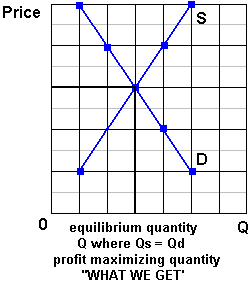
c. Assumptions: pure capitalism (for what is
capitalism see: chapter
2)
2. WHAT WE WANT: ALLOCATIVE EFFICIENCY
a.. Review :
(1) Allocative Efficiency
definition - using our limited resources
to produce:
- The quantity of goods and services that
maximizes society's satisfaction
- using resources to produce more CDs that
people want and fewer cassette tapes that they
don't want
- no shortages and no surpluses
(2) Benefit-Cost Analysis
definition -
the selection of ALL possible
alternatives where the marginal benefits are
greater than the marginal cost
select all where: MB >
MC
up to where: MB = MC
but never where: MB < MC
B. Allocative Efficiency is achieved where:
1. MSB=MSC
a. define Marginal Social Benefits (MSB)
b. define Marginal Social Costs (MSC)
c. therfore if society gets
all quantities where:
MSB > MSC
up to where: MSB = MSC
but never where: MSB < MSC
this will be the
quantity where society's Satisfaction will be maximized
or the allocatively efficient quantity
2. Graphically:
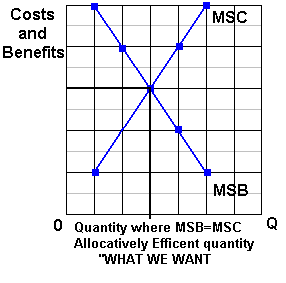
C. THEREFORE:
1. Businesses will produce the profit maximizing or
market equilibrium quantity - the quantity where Qd=Qs
2. Society wants the allocatively efficient quantity -
the quantity where MSB=MSC
3. WHAT WE GET = WHAT WE WANT if:
b. Market Demand = Marginal Social Benefits
(D=MSB)
1. law of diminishing marginal utility
2. assuming no positive externality (or spillover
benefit)s D=MSB
c. Market Supply = Marginal Social Costs
(S=MSC)
1. law of increasing costs
2. assuming no negative externality (or spillover cost)s
S=MSC
D. Competitive Markets and Allocative Efficiency
(MSB=MSC)
1. if there are no negative externality (or
spillover cost)s, then S = MSC,
2. if there are no positive externality (or spillover
benefit)s, then D = MSB,
3. Graphically:
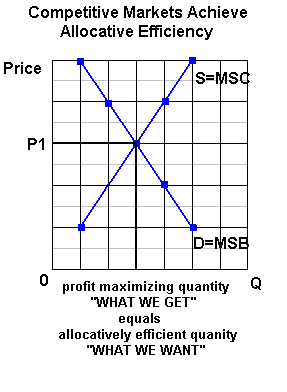
4. Then: WHAT WE GET = WHAT WE WANT and market economies
achieve allocative efficiency
|
In a market economy with no positive
externality (or spillover benefit)s and no
negative externality (or spillover
cost)s:
the profit maximizing or
market equilibrium quantity
(what we get)
WILL BE THE SAME AS
the allocative efficient quantity
(what we want)
|

D. Preview of Lessons 5a and 5b - 2 Parts:
1. Governments Causing Allocative Inefficiency
2. Markets Causing Allocative Inefficiency and the Role of
Government
II. Governments Causing Allocative
Inefficiency
A. Price Ceilings and Allocative Inefficiency
1. definition
2. graphically
3. effects
4. examples
a. World War II price controls
b. rent controls
c. credit card interest rates
d. anti-price gouging laws (plywood after a hurricane)
e. food price controls in LDCs
B. Price Floors (Supports) and Allocative
Inefficiency
1. definition
2. graphically
3. effects
4. examples
a. farm price supports
b. minimum wage
III. Economic Functions of Government
A. Two Main Roles:
1. Help the Market Achieve the 5 E's
2. Correcting the Markets when they don't achieve the 5 E's
B. Five Reasons for Government
Involvement
- Provide a legal and social framework in which the
economy can operate
- Maintain Competition
(Captitalism achieves efficiency only if there is
competition)
- Redistribution of income
(correcting the market's failure to achieve equity)
- Reallocation of resources
(correcting the market's failure to achieve efficiency)
- Stabilizing unemployment and inflation and promoting
economic growth
C. Legal and Social Framework
providing the legal foundation and a social
environment conducive to the effective operation of the market
system
D. Maintaining Competition
1. review competition
a. large numbers
b. free entry and exit
2. the problem with monopolies
a. higher prices
b. smaller quantities
3. role of government
a. preventing monopolies -- antitrust laws
b. regulating monopolies -- natural monopolies
E. Correcting Market Failure to Achieve
Equity
1. define equity
2. examples of income distribution
3. role of government
a. transfer payments
b. market intervention
c. progressive income taxes
F. Correcting Market Failure to Achieve Allocative
Efficiency
1. negative externality
(or spillover cost)s (negative externalities)
a. definition
TEXTBOOK: A cost imposed without compensation on
third parties by the production or consumption of sellers or
buyers.
CLASS: A negative externality (or spillover cost)
occurs if some of the costs of producing and consuming a
product "spillover" onto a third party who does not
benefit.
- not just the buyer
- not just the seller,
- but someone else must pay some of the costs of
production
Example: A paper manufacturer dumps toxic chemicals
into a river killing the fish sport fishers seek.
- buyer = purchaser of paper
- seller = paper manufacturer
- third party = people who fish, or live,
downstream
b. examples
a) pollution
b) cigarettes
c) alcohol
d) gasoline and pollution
d) party in dorm room and you're not invited
c. markets and inefficiency:
|
ON A GRAPH SHOW:
1) S and D for a product
2) MSC when there are NO negative externality
(or spillover cost)s (producer pays ALL
costs)
- Show the profit maximizing
quantity
- Show the allocatively efficient
quantity
(assume D=MSB, i.e. no positive externality (or
spillover benefit)s)
3) What happens to S if there ARE negative
externality (or spillover cost)s (the producer can
AVOID some costs)
4) What happens to P, Q, and efficiency WITH
negative externality (or spillover cost)s?
- what happens to the profit maximizing P
and Q? (Show on gragh)
- what is the allocatively efficient
quantity? (Show on graph)
5) RESULT:
- Does the market achieve allocative
efficiency when ther are negative externality
(or spillover cost)s?
- Is there an OVERallocation of resources
OR an UNDERallocation of resources?
- without the government would TOO MUCH or
TOO LITTLE be produced?
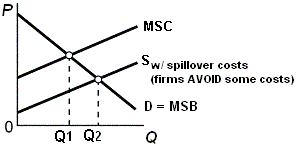
|
|
Negative Externalities and Allocative
Inefficiency:
Benefit-Cost Analysis Approach
|
Negative Externalities and Allocative
Inefficiency:
Consumer and Producer Surplus
Approach
|
|
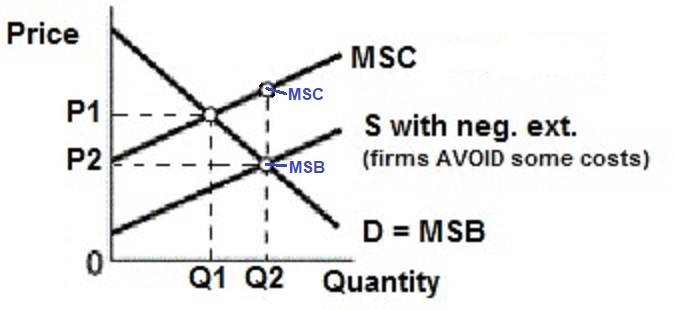
Overallocation of Resources: MSB <
MSC
|
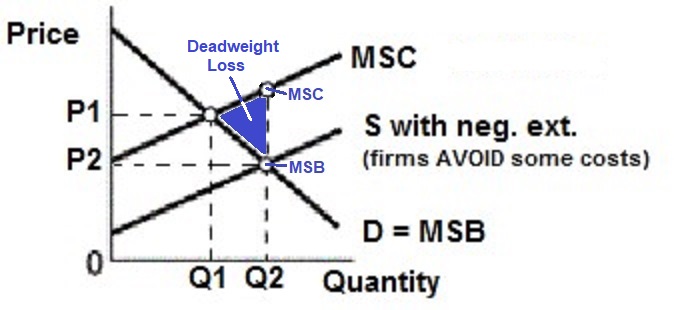
Overallocation of Resources: Deadweight
Loss
|
d. correcting for negative externality (or spillover
cost)s: What can the government do?
1) GOAL: to reduce production and get closer to
the allocatively efficient quantity
2) policies
- specific (excise) taxes on products with negative
externality (or spillover cost)s
- legislation/regulation (Direct Controls)
- gov't sets the amount
- gov't decides who
- market for pollution rights (MORE BELOW)
- gov't sets the amount
- market decides who
- RESULT:
- same amount of pollution as with direct
controls
- but MORE output from the same amount of
resources
- APPLICATION: SHOULD GAS PRICES BE HIGHER?
e. Other ways to correct for negative externality (or
spillover cost)s
1) Individual Bargaining: Coase Theorem
The idea first stated by economist Ronald Coase
that spillover problems may be resolved through private
negotiations of the affected parties.
Gov't may not be needed to achieve allocative
efficiency
(1) IF: property rights are clearly
defined
(2) IF: few people involved
(3) IF: negligible bargaining costs
2) Liability Rules and Lawsuits
(1) gov't may not be needed to achieve
allocative efficiency
(2) IF: property rights are clearly defined
(3) property rights protected in court
f. Another type of negative externality (or spillover
cost): Failure to provide for the future
a) explanation
b) role of government
c) example: space exploration
5b - Market Failures Continued (Positive
Externalities and Public Goods)
|
2. Positive Externality (or
spillover benefit)
a. definition
TEXTBOOK: A benefit obtained without
compensation by third parties from the production or
consumption of sellers or buyers.
CLASS: A positive externality (or spillover benefit)
occurs if some of the benefits of producing or consuming a
product "spillover" onto a third party who does not have to
pay
- not just the buyer
- not just the seller,
- but someone else benefits
Example: A beekeeper benefits when a neighboring
farmer plants clover.
- buyer = purchaser of clover
- seller = farmer
- third party = beekeeper
b. examples
a) education
b) Ski Areas and Ski Shops
c) parks
c. markets and inefficiency:
|
ON A GRAPH SHOW:
a) MSB and alloc eff. P and Q with NO positive
externality (or spillover benefit)s
- what is the profit maximizing
quantity?
- what is the allocatively efficient
quantity?
b) What happens to D if there are positive
externality (or spillover benefit)s and a consumer can
benefit without paying?
c) So what happens to P, Q, and efficiency WITH
positive externality (or spillover benefit)s?
- what is the profit maximizing
quantity?
- what is the allocatively efficient
quantity?
d) RESULT: an UNDERallocation of
resources
- too little would be produced without the
government
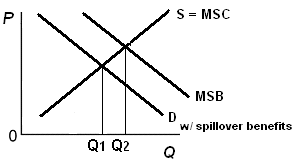
|
|
Positive Externalities and Allocative
Inefficiency:
Benefit-Cost Analysis Approach
|
Positive Externalities and Allocative
Inefficiency:
Consumer and Producer Surplus
Approach
|
|
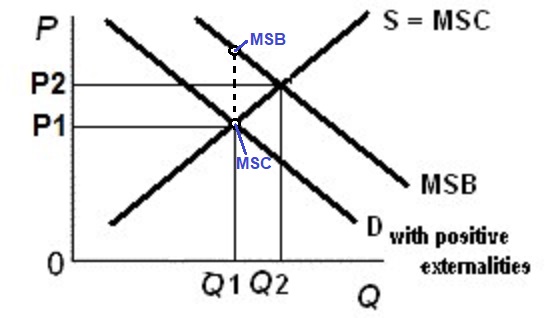
Underallocation of Resources: MSB > MSC
|
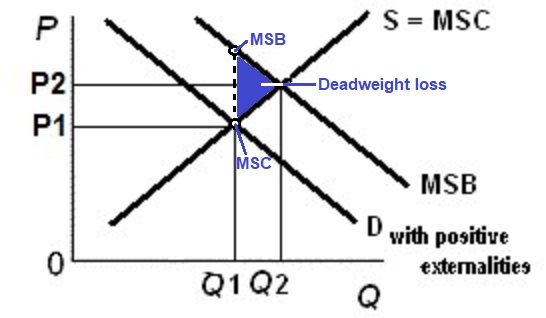
Underallocation of Resources: Deadwieght
Loss
|
d. Correcting for positive externality (or spillover
benefit)s - What can the government do?
1) GOAL: increase the quantity
2) HOW?
- increase demand (subsidize consumers)
- increase supply (subsidize suppliers)
- provide goods via the government
3. Public goods and services
a. definition
A good or service which is indivisible and to which
the exclusion principle does not apply
1) exclusion principle does not apply
The exclusion principle is: The ability
to exclude those who do not pay for a product from
receiving its benefits.
2) free-rider problem
because exclusion principle does not
apply
The inability of potential providers of an
economically desirable but indivisible good or service to
obtain payment from those who benefit because the
exclusion principle is not applicable.
3) indivisible good / nonrival
b. examples
1) lighthouse
2) national defense
3) immunizations
4) street lights
5) insect and flood control
c. markets and inefficiency
RESULT:
- an UNDERallocation of resources
- too little (none) will be produced without the
government
d. role of government:
allocating resources to public goods
e. Are the following public goods? If not why does the
government provide them?
1) public education
2) public parks
3) public libraries
G. Stabilization
1. unemployment and inflation
2. role of government
IV. A Market for Externality Rights: Buying
Pollution Permits
1. The old way: gov't forces all producers to reduce
pollution by the certain amount
2. Cap and Trade
a. CAP: Government sets (caps) the AMOUNT of
pollution allowed
(1) NOT elimination of pollution
(2) gov't sets the amount of permits allowed
(3) Gov't sells pollution permits
(4) vertical Supply curve for pollution permits
b. TRADE: The market decides WHO pollutes
c. RESULT: More goods produced than if gov't forced
all producers to reduce pollution
V. Society's Optimal Amount of Externality Reduction
A. Benefit-Cost Analysis
B. Shifts in Locations of Curves








